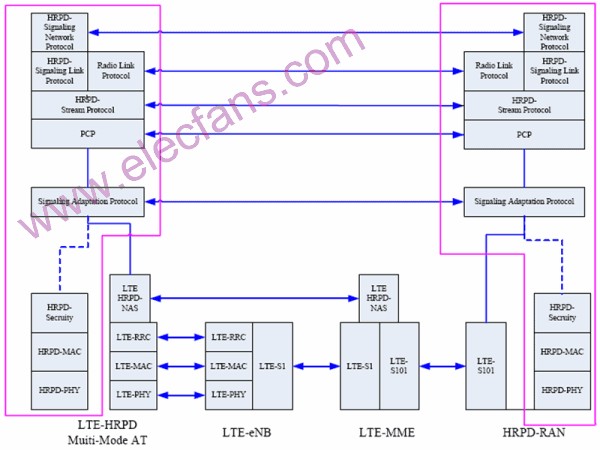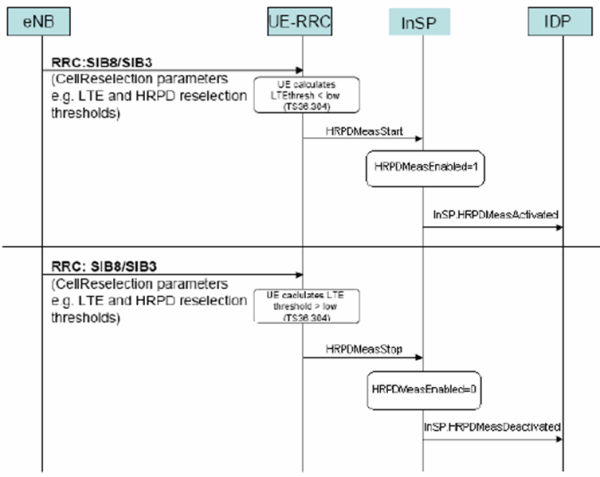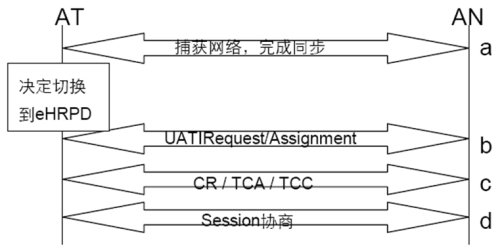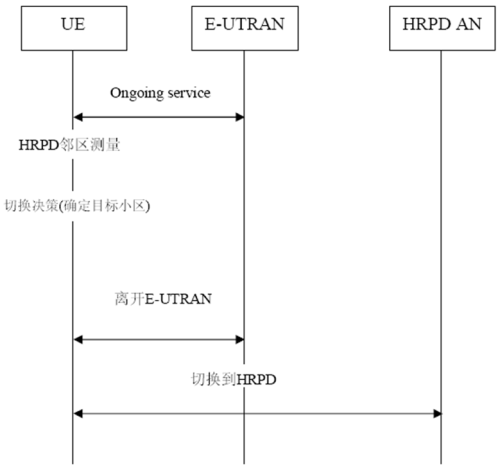Foreword
Due to many factors in the technology industry chain and business development, major mobile operators around the world have proposed the development direction of LTE long-term evolution, especially the main operators of the original CDMA camp have also abandoned the long-term evolution of CDMA technology and chose LTE . Qualcomm also announced that it would abandon UMB technology and switch to LTE.
At present, CDMA network operators around the world are actively studying the schemes and strategies for CDMA network evolution to LTE. Various evolution schemes are still being studied and discussed. Standardization bodies such as 3GPP / 3GPP2 have also begun research and discussion on corresponding technical standards. At present, the hotspots discussed in international standards are CDMA / LTE voice interoperability schemes and CDMA / LTE data interoperability schemes. Among them, data interoperation mainly includes optimized switching and non-optimized switching.
The existing CDMA / LTE data interoperability solution is mainly based on the network architecture proposed by 3GPP TS23.402. It is necessary to upgrade the CDMA HRPD wireless network to an eHRPD network and access the eHRPD network to the EPC core network.
3GPP and 3GPP2 have corresponding specifications for the E-UTRAN and eHRPD handover mechanisms. The overall handover scheme defined by 3GPP is in the specification TS23.402, which defines the bidirectional handover of E-UTRAN and eHRPD, including the active and idle handover from E-UTRAN to eHRPD, and the activation from eHRPD to E-UTRAN State switching and idle state switching.
The 3GPP2 specifications are mainly based on the interoperability architecture defined by 3GPP. The contents that need to be modified in the CDMA network are mainly in C.S0087, A.S0022 and X.S0057. Among them, C.S0087 mainly defines the content of the air interface part in the interoperation of eHRPD and E-UTRAN, A.S0022 mainly defines the content of the A interface part in the interoperation of eHRPD and E-UTRAN, X.S0057 mainly defines the eHRPD and E -Content of the core network part in UTRAN interoperation. This article mainly discusses the air interface technical solution in C.S0087.
Optimized switching
Optimize the switching process
In order to realize the optimal switching scheme between CDMA / LTE, a new protocol layer SAP (Signaling AdaptaTIon Protocol signaling adaptation layer) is added in the HRPD air interface protocol connection layer. When the eAT / UE is in tunnel mode, eHRPD signaling on the eAT / UE side is routed to the LTE-eHRPD tunnel through SAP. The specific protocol stack structure is shown in the following figure.

Figure 1 CDMA / LTE optimized handover air interface protocol stack structure
As can be seen from the above figure, if the eAT / UE resides in the eHRPD network, the air interface protocol is still processed according to the original air interface protocol, which is the protocol stack in the red wire frame in the above figure. If the eAT / UE resides in the LTE network and needs to switch to the eHRPD network, the eHRPD connection parameters and session parameters need to be negotiated in advance through the E-UTRAN air interface. At this time, the eAT / UE needs to transmit the signaling to the E-UTRAN air interface to The eNB and then the MME are connected from the MME to the eHRPD network through the S101 interface to perform parameter negotiation. This working mode is called the tunnel mode. The specific switching process has three main steps, as shown in the following figure:
Figure 2 The main process of CDMA / LTE optimized handover
The main process of CDMA / LTE optimized handover:
Pre-registration process
The pre-registration process is that the terminal completes the eHRPD registration process (UATI application, session configuration negotiation, etc.) in the E-UTRAN area in advance through the tunnel between LTE-eHRPD, which shortens the LTE-eHRPD switching time and meets the needs of real-time services Handover delay requirements. The main processes of pre-registration in the air interface are:
â—† When eAT / UE moves to the E-UTRAN Pre-Registration Zone (PreRegistraTIon Zone), the OMP common parameter PreregistraTIonAllowed = 1, initiates the pre-registration process;
â—† eAT / UE establishes a tunnel to the eHRPD network. The eAT / UE allocates UATI with the eHRPD network through the signaling tunnel, negotiates the configuration of protocol parameters, and establishes a session.
In the above pre-registration process, it should be noted that OMP is the broadcast information of eHRPD. The premise for eAT / UE to listen is that the terminal has been decided by the LTE network to pre-register for the eHRPD network, so that the terminal will listen to OMP messages Of course, the OMP message is transferred to the LTE network through the tunnel S101 interface and sent to the eAT / UE through the E-UTRAN air interface.
The eHRPD network parameters that the eAT / UE can obtain through the E-UTRAN air interface message mainly include: eHRPD network system time, search window, neighboring band, PN, etc. 3GPP defines a pre-registration area. When eAT / UE moves between different pre-registration areas, UATI needs to be reassigned.
Handover preparation process
The signaling flow of the handover preparation process is shown in the following figure:

Figure 3 CDMA / LTE optimized handover preparation process
â—† E-UTRAN protocol in eAT / UE decides whether to initiate or stop eHRPD measurement according to the measurement threshold issued by LTE air interface;
â—† The eHRPD air interface protocol sets the HRPDMeasEnabled parameter, and judges whether to conduct eHRPD pilot measurement based on this parameter value;
â—† E-UTRAN protocol decides whether to switch according to the measurement result.
Switch execution process
For CDMA / LTE handover, it mainly involves two states of handover, one is active state handover (AcTIve Handoff), and the other is idle state handover (Idle Handoff).
Active state switching
When the eAT / UE is in the service connection state in the LTE network and the E-UTRAN decides to let the eAT / UE switch to the eHRPD network, the eAT / UE will perform the active state switching after the handover preparation process. The specific switching operations mainly include:
a) The eAT / UE sends a connection request (Connection Request) to the eHRPD network through the tunnel, with a routing update message (RUM);
b) eHRPD sends a traffic channel allocation message (TCA) to eAT / UE through the tunnel, and provides the initial power reference (HRPDOpenLoopParams message) and reverse channel silence time parameters (HRPDSilencePeriodParams message) to eAT / UE;
c) eAT / UE uses the power reference provided by eHRPD to calculate the initial reverse channel power;
d) eAT / UE performs handover operation according to the calculated reverse channel power;
e) After the eAT / UE successfully switches to the eHRPD network, it continues to remain active in the eHRPD network.
f) Idle state switching
When the eAT / UE is in the idle state in the LTE network, and the E-UTRAN decides to let the eAT / UE switch to the eHRPD network, the eAT / UE will perform the idle switch after going through the handover preparation process. The idle state switching is relatively simple. The eAT / UE mainly performs network reselection on the basis of handover preparation. The eAT / UE will change from the Idle state in the LTE network to the Dormant state in the eHRPD network. However, after the handover in the idle state is completed, the eAT / UE needs to send an instruction through the eHRPD air interface to notify the eHRPD that an Idle Handoff has occurred.
SAP Agreement
In order to support the interoperability function of CDMA / LTE data optimization handover, a very important protocol SAP protocol has been added to the air interface protocol of eHRPD network. If the terminal uses the optimized data switching function under the LTE network, the Inter-RAT SAP protocol will be enabled.
As shown in Figure 1, when eAT / UE works in LTE mode, the Inter-RAT SAP protocol in eAT / UE and eHRPD together provides a two-way virtual connection carried on the LTE network. The virtual connection is transparent to the upper layer connection. After the virtual connection is established, the Inter-RAT SAP protocol in the Open state encapsulates eHRPD signaling and RLP packets, adds its own header, and serves as a routing identifier, which is then passed through the LTE tunnel. With this virtual connection, the upper layer protocol can communicate without the air interface connection of the eHRPD network. When the eAT / UE switches to the eHRPD working mode, the Inter-RAT SAP protocol is in the Close state, no header is added to the data packet, and all transmitted data packets are directly forwarded to the security layer.
Non-optimal switching
Non-optimized switching process
Non-optimized switching does not use tunnels to negotiate switching parameters and air interface sessions in advance, but eAT / UE directly leaves the air interface of the source network and moves to the destination network to establish air interface connections and IP session connections. Therefore, non-optimal switching is suitable for delay Insensitive business. The specific process of non-optimized switching is divided into two processes: pre-registration and switching execution.
Pre-registration process
The pre-registration process in non-optimized switching does not support pre-registration in tunnel mode. The eAT / UE switches to the eHRPD network. If there is no HRPD session, registration needs to be initiated. However, it is also possible that the eAT / UE has already registered in the eHRPD network in advance, depending on the mode of the terminal.
Single-issue, single-receive terminal: Whether in Active State or Idle State, to complete eHRPD pre-registration, the terminal needs to switch to the eHRPD network to complete the pre-registration process.
Single-transmission and dual-reception terminal: When the LTE mode does not require a transmitter or the LTE mode is in the Idle state, the terminal can go to eHRPD for registration and maintain registration information.
Dual-transmission and dual-reception terminal: You can register on the E-UTRAN and eHRPD networks at the same time and maintain subsequent registration information.
Regardless of the terminal mode, the specific pre-registration process for non-optimized switching is shown in the following figure:

Figure 4 CDMA / LTE non-optimized handover pre-registration process
The first is that eAT / UE completes the network acquisition and synchronization process with eHRPD, then UATI allocation, and other allocation processes such as CR / TCA / TCC, and finally the session negotiation process, which is basically the same as the ordinary eAT registration process. For terminals already registered in eHRPD, steps b and d are not required.
Switch execution process
The non-optimized switching execution process is mainly performed by the terminal itself. The main processes are:
â—† The eAT / UE in the E-UTRAN network triggers the measurement process of an eHRPD neighboring cell;
â—† eAT / UE makes a handover decision based on the measurement results and selects the target cell. In this step, eAT / UE does not need to report to the network;
â—† eAT / UE releases the connection with E-UTRAN and leaves E-UTRAN;
â—† The eAT / UE initiates the access process to access the corresponding target cell in the eHRPD network.
The specific switching process is shown below:

Figure 5 CDMA / LTE non-optimized handover process
Switching scheme comparison
Optimized handover By implementing the eHRPD pre-registration process in the E-UTRAN network, the eAT / UE is ready to access the eHRPD network in advance. Therefore, compared with non-optimized handover, the delay of handover can be greatly reduced, which can meet real-time Business needs. However, the optimized handover needs to establish a tunnel to the eHRPD network in the EPC / LTE network. Therefore, it is necessary to support the interoperable interfaces S101 and S103. At the same time, the optimized handover modifies the air interface of the eHRPD network more.
Non-optimized switching is easier to deploy than optimized switching, does not need to support interoperable interfaces S101 and S103, and there are few modifications to the air interface of the eHRPD network. However, since eAT / UE needs to perform network access and parameter negotiation again in the target network, the handover delay of non-optimized handover is long, which is not suitable for services with high real-time requirements.
During the deployment of CDMA / LTE data interoperable networks, operators also need to consider business requirements and network equipment costs. If there is no demand for real-time services in the initial stage, the non-optimized switching scheme can be adopted first. When there is a need for real-time services, especially VoIP voice services, the network equipment is upgraded to support the optimized switching scheme.
Considering that the non-optimized switching has less network changes and at the same time does not make particularly many requirements on the functions of the terminal chip, so the industry is also discussing the enhancement scheme of non-optimized switching, which is comprehensive from the aspects of network implementation complexity and switching performance. Consider to obtain the best CDMA / LTE data interoperability solution.
Conclusion
This article discusses and analyzes the optimized and non-optimized handover schemes for CDMA and LTE data interoperability. The technical characteristics and implementation mechanism of the two handover schemes are analyzed in detail. The network implementation is proposed for the characteristics of the two handover schemes. Strategies and recommendations.
The Mylar Speaker solutions come in a variety of shapes and sizes. We can provide various mounting configurations and performance alterations to fit any industrial application. Our Mylar speakers produce excellent sound output (dB) at specified frequency ranges. The unique characteristics of a Mylar cone allow us to keep tight tolerances during the manufacturing process. Additionally, Mylar is easily and consistently moldable, creating a cost-effective solution, time after time. It`s also beneficial in applications that are exposed to excessive moisture or humidity since Mylar has a high resistance to environmental factors.
Mylar Speaker
Mylar Speaker,Mylar Tweeter,Mylar Cone Speaker,Cellphone Mylar Speaker
Jiangsu Huawha Electronices Co.,Ltd , https://www.hnbuzzer.com